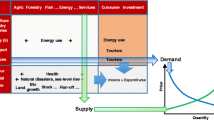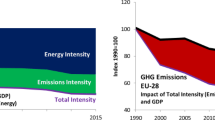Abstract
In terms of geological shifts in climate, climate policy is a very young field. However, during the last two decades it has developed at a rapid pace. In 1987, the Brundtland Report first used the concept of sustainable development, followed in 1988 by the first meeting of the Intergovernmental Panel on Climate Change (IPCC) in Toronto. The establishment of the United Nations Framework Convention on Climate Change (UNFCCC) in 1992 marked the birth of global climate policy. For the first time in history governments of almost all nations gathered to discuss the effects and consequences of and measures to be taken against global warming and agreed on the principle of “common but differentiated responsibilities”. The first decade of climate policy culminated in 1997 in the signing of the Kyoto Protocol, in which industrialized countries (37 so-called “Annex B countries”), agreed to reduce anthropogenic emissions of six greenhouse gases (GHGs) by 5.2% below 1990 levels during the Kyoto commitment period, 2008–2012 (Article 3, UNFCCC 1997).
Access this chapter
Tax calculation will be finalised at checkout
Purchases are for personal use only
Similar content being viewed by others
Notes
- 1.
The UNFCCC was signed May 9th, 1992 as part of the UN Conference on Development and Environment (UNCED) in Rio de Janeiro and entered into force March, 1994. By early 2008, 192 nations have ratified the UNFCCC, while 154 nations had signed the UNFCCC in 1992 in Rio de Janeiro.
- 2.
This was done by differentiating countries into “Annex I”, i.e., industrialized countries and “Non-Annex I”, i.e., developing countries.
- 3.
GHGs covered under the Kyoto Protocol are carbon dioxide (CO2), Methane (CH4), Nitrous oxide (N2O), Hydrofluorocarbons (HFCs), Perfluorocarbons (PFCs), and Sulphur hexafluoride (SF6). All GHGs can be restated in terms of CO2-equivalent (CO2 eq.) by multiplying their quantity in tons with the 100 year global warming potential (GWP) of the respective greenhouse gas. Until October 2008, the Kyoto Protocol had been ratified by 182 countries.
- 4.
This mechanism, although often omitted in the list of flexible mechanisms, is used by the European Union to achieve the emission targets as a group rather than as individual countries.
- 5.
There is a wealth of abbreviations in the Kyoto carbon market. For convenience, the most frequently used terms can be found in the Annex to this paper.
- 6.
The most recent version of the “Tool for the demonstration and assessment of Additionality” has been approved by EB 39 in its fifth version.
- 7.
The ratification by the Russian Federation was required to fulfil the condition that more than 55% of CO2 emissions from Annex-I countries are included in the ratifying group (Article 25, KP). This was due to the refusal of the US to ratify, as the US was responsible for 36% of the emissions.
- 8.
Interestingly, 39 CDM projects were submitted before Russia’s ratification, showing that some market actors were willing to take up the Kyoto risk.
- 9.
Axel Michaelowa and Tobias Koch examine Russia’s possible reasons, including interest group rent seeking and Duma power issues, for not having ratified the protocol despite generous counting of sinks (and doubling of these sinks in Marrakech) and allocation of “hot air” permits (Michaelowa and Koch 2002 pp. 563). Alain Bernard et al. show in their paper using computable general equilibrium models how Russia faces a trade-off to maximise their revenue from emission permits versus the revenue from fossil energy exports (Bernard et al. 2003).
- 10.
The positive experience gained by the US through the SO2 emissions trading regime, established through the Acid Rain Programme of the Clean Air Act in 1990, should not be underestimated here.
- 11.
Currently, the discussion focuses on reforming the clean development mechanism, especially the CDM institutions and the approval system. However, consensus among carbon-related businesses is to maintain the CDM as a tool to reduce greenhouse gases.
- 12.
A good enforcement mechanism ensures that the environmental integrity of the treaty is ensured.
- 13.
Verified or Voluntary Emission Reductions (VERs), which belong to the voluntary market, are not part of the Kyoto compliance market. We will only look at the Kyoto market.
- 14.
The CDM Executive Board is following the guidelines decided by the Conference and Meeting of the Parties (COP/MOP) and is fully accountable to COP/MOP (3/CMP.1, Annex, paragraph 5).
- 15.
The CDM AP and the Meth Panel was established by EB 3; the A/R WG at EB 14 (Annex 8); the SSC WG following Decision 21/CP.8 in New Delhi, 2002 and the EB-RIT at EB 29. The Small Scale Panel had a short existence between April and August 2002, met three times and drafted simplified modalities and procedures for small scale projects.
- 16.
The Kyoto market developed a whole array of new terms and abbreviations. A glossary of terms is attached at the end of this article for reference.
- 17.
Another challenge that can arise from such a multi-layer structure is the anti-commons problem, which means that certain players can delay progress if it is in their (rent-seeking) interest follow such a strategy. However, the rent-seeking argument loses some momentum as the governmentally established entities and their private counterparts are under high critical scrutiny by the public and the media (Buchanan and Yoon, 2002).
- 18.
In a recent report validators (so-called Designated Operational Entities - DOEs) have stated that more than 100 projects that are currently in the validation phase will never reach registration due to additionality reasons. However, the data remains confidential for reputational issues of the respective project developers, who handed in the project (Dornau 2008).
- 19.
For a good analysis and an overview of how carbon contracts can be structured (see Streck and Freestone 2005, Chap. 20).
- 20.
China is very supportive of its CDM project developers, e.g., by providing a standard electricity grid emissions factor and introducing a maximum consultant fee for PDD development. On the other hand, the Chinese government utilizes China’s market power to tax CER revenues, e.g., HFC-23 by 65%, as long as this does not adversely impact China’s market position.
- 21.
The threat of environmental litigation can also be an incentive for firms to engage in purchasing CERs (Streck and Freestone 2005).
- 22.
Energy providers have profited substantially during phase I of the EU ETS by free allocation of allowances by passing through the opportunity cost of allowances to consumers and other businesses. This has amounted by conservative estimates to about € 8–10 billion (Sijm et al. 2006; Cramton and Kerr 2002; Hepburn et al. 2006; Neuhoff et al. 2006). Therefore, for 2013–2020 full auctioning for allowances to energy providers was envisaged before lobbying by East European states led to some exemptions. Auctioning gives a clear and credible signal to energy generators to change their investment behavior.
- 23.
The 2008 financial crisis was caused by the sub-prime crisis in which mortgage obligations had been restructured multiple times with the help of Special Purpose Vehicles (SPVs). The restructured product carried a better rating than its inherent risk level would suggest. As many CER transactions are structured with the help of SPVs, it is crucial for the credibility of the market to be assured of the quality and real risk of credits.
References
Bernard A. Paltsev S, Reilly J et al (2003) Russia’s Role in the Kyoto Protocol. MIT Press, Cambridge MA
Buchanan JM, Yoon YJ (2002) Globalization as framed by the two logics of trade. In: Independent Review-Oakland, 6(3): 399–406
Buchner B, Ellerman A (2006) Over-Allocation or Abatement? A Preliminary Analysis of the EU ETS Based on the 2005 Emissions Data. FEEM Fondazione Eni Enrico Mattei Research Paper, Working Paper 139.06, Milan
Burtraw D, Palmer K, Bharvirkar K et al (2001) The Effect of Allowance Allocation on the Cost of Carbon Emission Trading. Resources for the Future Discussion Paper 01–30, Washington. http://www.rff.org/documents/RFF-DP-01-30.pdf. Accessed 15 August 2010
Capoor K, Ambrosi P (2008) State and trends of the Carbon Market 2008. World Bank, Washington DC
Capoor K, Ambrosi P (2007) State and Trends of the Carbon Market 2007. World Bank, Washington DC
Coase R (1960):The problem of social cost. J Law Econ 3: 1–44
Cramton P, Kerr S (2002) Tradeable carbon permit auctions How and why to auction not grandfather. Energ Policy 30: 333–345
Dales J (1968) Pollution, Property and Prices: An Essay in Policy-Making and Economics. Toronto University Press, Toronto
Dornau R (2008) The full picture. Carbon Finance 14 April 2008. http://www.carbon-financeonline.com
ECX European Climate Exchange (2008): EUA Future Prices. http://www.europeanclimateexchange.com/default_flash.asp. Accessed 29 November 2008
Ellis J, Kamel S (2007) Overcoming Barriers to Clean Development Mechanism Projects. OECD Organisation for Economic Co-operation and Development, Paris
EU Commission (2007) Emissions trading: Commission adopts amendment decision on the Slovak National Allocation Plan for 2008 to 2012. Press release IP/07/1869. EU Commission, Brussels
Flues F, Michaelowa K, Michaelowa A (2008) UN approval of greenhouse gas emission reduction projects in developing countries: The political economy of the CDM Executive Board. Working Paper 35. Center for Comparative and International Studies, Zurich. http://www.cis.ethz.ch/publications/publications/WP36_Kammerer_German.Regulation
Geres R, Michaelowa A (2002) A qualitative method to consider leakage effects from CDM and JI projects. Energ Policy 30: 461–463
GTZ CDM (2008) CDM Highlights No. 57, March 2008. http://cdm.ccchina.gov.cn/WebSite/CDM/UpFile/File1739.pdf. Accessed 22 March 2008
Hepburn C, Grubb M, Neuhoff K et al (2006) Auctioning of EU ETS phase II allowances: how and why. Clim Policy 2006: 137–160
IDEAcarbon (2008): IDEAcarbon pCER Index™ Results. http://www.reutersinteractive.com/ClientFiles/7aa11c3c-dd52-447d-87b8-ac8670a683c8/IDEAcarbon%20pCER%20Index%20Results%209.pdf. Accessed 22 May 2008
Jepma CJ (2007) CER-EUA Arbitrage: a Trader’s Paradise? Note from the editor at Joint Implementation Network Netherlands (JIN). http://www.jiqweb.org/cjj406.htm. Accessed 8 December 2008
Kossoy A, Ambrosi P (2010) State and trends of the Carbon Market 2008, World Bank, Washington DC
Lütken S, Michaelowa A (2008) Corporate strategies and the Clean Development Mechanism. Edward Elgar, Cheltenham
Metz B (1995) What the Parties to the Climate Convention should do about it. In: Jepma C (ed) The Feasibility of Joint Implementation. Kluwer, Dordrecht: 163–176
Michaelowa A, Gagnon-Lebrun F, Hayashi D et al (2007) Understanding CDM Methodologies: A guidebook to CDM Rules and Procedures. Defra, London
Michaelowa A (1995): Joint Implementation: a promising instrument for climate protection. Intereconomics 30: 163–171
Michaelowa A (1998) Climate policy and interest groups – a public choice analysis. Intereconomics 33: 251–259
Michaelowa A, Koch T (2002) Rußland: der passende Schlüssel zum Inkrafttreten des Kioto-Protokolls? Wirtschaftsdienst 82: 561–564
Neuhoff K, Martinez KK, Sato M (2006) Allocation, incentives and distortions: the impact of EU ETS emissions allowance allocations to the electricity sector. Clim Policy 6: 73–91
Reuters (2008): CER Future Prices. http://www.europeanclimateexchange.com/default_flash.asp. Accessed 29 November 2008
Richardson J (2008) Needful things. Trading Carbon 2: 30–32
Sijm J, Neuhoff K, Chen Y (2006) CO2 cost pass through and windfall profits in the power sector. ClimPolicy: 49–72
Streck C, Freestone D (2005) Legal Aspects of Implementing the Kyoto Protocol Mechanisms: Making Kyoto Work. Oxford University Press, Oxford
UNFCCC (1997): Kyoto Protocol to the United Nations Framework Convention on Climate Change. UNFCCC United Nations Framework Convention on Climate Change, Bonn
Author information
Authors and Affiliations
Corresponding author
Editor information
Editors and Affiliations
Rights and permissions
Copyright information
© 2011 Springer-Verlag Berlin Heidelberg
About this chapter
Cite this chapter
Vasa, A., Michaelowa, A. (2011). Uncertainty in Climate Policy – Impacts on Market Mechanisms. In: Gramelsberger, G., Feichter, J. (eds) Climate Change and Policy. Springer, Berlin, Heidelberg. https://doi.org/10.1007/978-3-642-17700-2_5
Download citation
DOI: https://doi.org/10.1007/978-3-642-17700-2_5
Published:
Publisher Name: Springer, Berlin, Heidelberg
Print ISBN: 978-3-642-17699-9
Online ISBN: 978-3-642-17700-2
eBook Packages: Earth and Environmental ScienceEarth and Environmental Science (R0)




